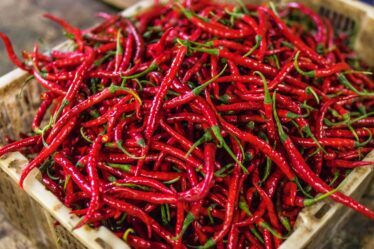
Ginger is a popular spice that has been used for centuries in various cultures for its medicinal properties. It is derived from the root of the ginger plant, which is native to Southeast Asia. Ginger has a strong, spicy flavor and is commonly used in cooking and baking. However, it is not just a flavorful addition to meals – ginger also offers a wide range of health benefits.
One of the key health benefits of ginger is its anti-inflammatory properties. Inflammation is a natural response by the body to protect against injury or infection. However, chronic inflammation can lead to various health problems, such as heart disease, diabetes, and arthritis. Ginger contains compounds called gingerols and shogaols, which have been shown to reduce inflammation in the body.
Key Takeaways
- Ginger has been used for centuries in traditional medicine for its health benefits.
- The anti-inflammatory properties of ginger have been scientifically proven.
- Ginger is a natural remedy for nausea and digestive issues.
- Ginger can be used for pain relief and is available in various forms.
- Ginger can be incorporated into daily routines through recipes, drinks, skincare, and beauty products.
Ginger in Traditional Medicine: A Brief History
Ginger has been used in traditional medicine for thousands of years. It has been a staple in Ayurvedic medicine, which originated in India over 5,000 years ago. Ayurvedic practitioners believe that ginger can help balance the body’s energy and promote overall health and well-being.
In addition to Ayurvedic medicine, ginger has also been used in traditional Chinese medicine (TCM). TCM practitioners believe that ginger can help improve digestion, relieve nausea, and reduce pain. Ginger is often used in TCM formulas to treat conditions such as colds, coughs, and digestive disorders.
The Science Behind Ginger’s Anti-Inflammatory Properties
Ginger’s anti-inflammatory properties have been studied extensively by scientists. The active compounds in ginger, such as gingerols and shogaols, have been shown to inhibit the production of inflammatory chemicals in the body.
One study published in the Journal of Medicinal Food found that ginger extract reduced inflammation markers in people with osteoarthritis. Another study published in the Journal of Natural Products found that gingerols inhibited the production of inflammatory chemicals in human cells.
These studies suggest that ginger may be an effective natural remedy for reducing inflammation in the body. By incorporating ginger into your diet, you may be able to reduce your risk of chronic inflammation and the associated health problems.
Ginger as a Natural Remedy for Nausea and Digestive Issues
| Study | Results |
|---|---|
| A 2011 study published in the Journal of Alternative and Complementary Medicine | Ginger was found to be effective in reducing nausea and vomiting in patients undergoing chemotherapy. |
| A 2015 study published in the Journal of Gastroenterology and Hepatology | Ginger was found to be effective in reducing symptoms of functional dyspepsia, including bloating, fullness, and nausea. |
| A 2016 study published in the Journal of Nutritional Science and Vitaminology | Ginger was found to be effective in reducing symptoms of motion sickness, including nausea and vomiting. |
| A 2018 study published in the Journal of Evidence-Based Integrative Medicine | Ginger was found to be effective in reducing symptoms of irritable bowel syndrome, including abdominal pain and bloating. |
Ginger has long been used as a natural remedy for nausea and digestive issues. It is commonly recommended for pregnant women experiencing morning sickness, as well as individuals undergoing chemotherapy or surgery.
The active compounds in ginger, such as gingerols and shogaols, have been shown to have anti-nausea properties. They work by blocking certain receptors in the brain that trigger nausea and vomiting.
Several studies have supported the use of ginger for nausea and digestive issues. A review of 12 studies found that ginger was effective in reducing nausea and vomiting in pregnant women. Another study published in the Journal of Alternative and Complementary Medicine found that ginger reduced nausea and vomiting in patients undergoing chemotherapy.
Ginger for Pain Relief: How It Works and What to Use
Ginger has also been shown to have pain-relieving properties. The active compounds in ginger, such as gingerols, have been found to inhibit pain-causing chemicals in the body.
One study published in the Journal of Pain found that ginger extract reduced muscle pain by 25%. Another study published in the Journal of Phytotherapy Research found that ginger extract reduced menstrual pain by 34%.
There are several forms of ginger that can be used for pain relief. Ginger tea is a popular option, as it can be easily made by steeping fresh or dried ginger in hot water. Ginger capsules and extracts are also available for those who prefer a more concentrated form of ginger.
Ginger Recipes: From Spicy Stir-Fries to Soothing Teas

Ginger can be incorporated into a wide range of recipes, both savory and sweet. It adds a spicy, aromatic flavor to dishes and can be used in everything from stir-fries to baked goods.
For savory dishes, ginger can be added to stir-fries, soups, and marinades. It pairs well with ingredients such as garlic, soy sauce, and chili peppers. For a simple ginger stir-fry, sauté sliced ginger with vegetables and your choice of protein in a hot pan.
For sweet dishes, ginger can be used in baked goods such as cookies, cakes, and muffins. It adds a warm, spicy flavor that complements ingredients such as cinnamon and nutmeg. For a delicious gingerbread cookie recipe, combine flour, sugar, butter, molasses, ginger, cinnamon, nutmeg, and cloves. Roll out the dough, cut into shapes, and bake until golden brown.
Ginger in Drinks: Cocktails, Smoothies, and More
Ginger can also be used to make a variety of refreshing drinks. It adds a zesty kick to cocktails, smoothies, and teas.
For cocktails, ginger can be muddled with fresh fruit and mixed with your choice of alcohol. For example, you can muddle fresh ginger with strawberries and lime juice, then mix with vodka and soda water for a refreshing ginger strawberry cocktail.
For smoothies, ginger can be blended with fruits such as pineapple or mango for a tropical twist. Simply add fresh or powdered ginger to your favorite smoothie recipe for an extra burst of flavor.
For teas, ginger can be steeped in hot water along with other herbs or spices. Ginger tea is known for its soothing properties and can help relieve digestive issues or calm an upset stomach. Simply steep fresh or dried ginger in hot water for 5-10 minutes, then strain and enjoy.
Ginger for Skincare: DIY Masks and Scrubs
In addition to its culinary uses, ginger can also benefit the skin. It has antioxidant and anti-inflammatory properties that can help improve the appearance of the skin and reduce inflammation.
One way to incorporate ginger into your skincare routine is by making DIY masks and scrubs. For a simple ginger face mask, combine grated ginger with honey and apply to clean, dry skin. Leave on for 10-15 minutes, then rinse off with warm water. This mask can help brighten the skin and reduce inflammation.
For a ginger body scrub, combine grated ginger with sugar and coconut oil. Gently massage the scrub onto damp skin in circular motions, then rinse off with warm water. This scrub can help exfoliate the skin and leave it feeling soft and smooth.
Ginger in Beauty Products: The Latest Trends and Innovations
Ginger has also become a popular ingredient in beauty products. It is often used in skincare products such as cleansers, toners, and serums.
The benefits of using ginger in beauty products include its antioxidant and anti-inflammatory properties. It can help protect the skin against free radicals, reduce inflammation, and promote a healthy complexion.
Some beauty products also combine ginger with other natural ingredients for added benefits. For example, ginger can be combined with turmeric for a brightening effect, or with green tea for an antioxidant boost.
Incorporating Ginger into Your Daily Routine for a Healthier, Happier Life
In conclusion, ginger is a versatile spice that offers a wide range of health benefits. From reducing inflammation to relieving nausea and pain, ginger has been used for centuries in traditional medicine and is supported by scientific studies.
Incorporating ginger into your daily routine can be as simple as adding it to your meals or drinks. Whether you prefer savory stir-fries or soothing teas, there are countless ways to enjoy the flavor and health benefits of ginger.
Additionally, ginger can be used in DIY skincare recipes or found in beauty products for added benefits to the skin. Its antioxidant and anti-inflammatory properties can help improve the appearance of the skin and promote overall wellness.
By incorporating ginger into your daily routine, you can experience the many health benefits of this powerful spice and live a healthier, happier life. So why not give it a try and start reaping the benefits of ginger today?
If you’re a fan of the unique and invigorating flavor of ginger, you’ll love this article on Flavorful Sips. They delve into the wondrous world of smoothies, where you can explore, experiment, and enjoy a variety of delicious concoctions. One particular smoothie recipe that caught my attention is their Ginger Peach Smoothie. It combines the zesty kick of ginger with the sweet and juicy flavors of peaches, creating a refreshing and revitalizing drink. If you’re looking to add some excitement to your smoothie routine, be sure to check out this article at Flavorful Sips.



